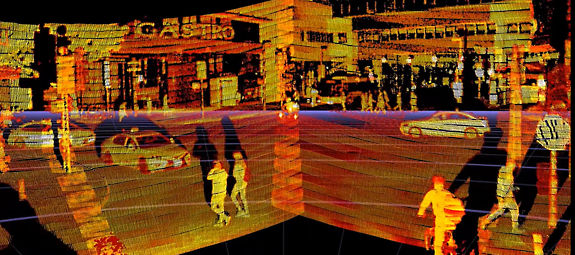 PITTSBURGH, PA, Jan 5, 2022 – Innoviz Technologies is using Ansys simulation solutions to successfully drive the technology behind their unique automotive-grade LiDAR sensor and achieve autonomy for their customers—while reducing development time and costs. Ansys enables Innoviz Technologies to meet their customers’ objectives for durability, reliability, and affordability in a LiDAR design that is seamlessly integrable into Level 3-5 autonomous vehicles.
PITTSBURGH, PA, Jan 5, 2022 – Innoviz Technologies is using Ansys simulation solutions to successfully drive the technology behind their unique automotive-grade LiDAR sensor and achieve autonomy for their customers—while reducing development time and costs. Ansys enables Innoviz Technologies to meet their customers’ objectives for durability, reliability, and affordability in a LiDAR design that is seamlessly integrable into Level 3-5 autonomous vehicles.

Innoviz LiDAR 3D point cloud
A study from the US Department of Transportation’s National Highway Traffic Safety Administration found the majority of serious crashes are caused by human error, a statistic that is incentivizing autonomous vehicle development to improve safety on the road. Autonomous vehicles depend on the sensing capability of various components, including LiDARs, radars and cameras. LiDAR delivers the high-resolution, long-range 3D image perception needed to safely guide vehicle movement. The challenge for automotive manufacturers is that available LiDARs are not close to meeting industry standards for performance, size, reliability, and cost perception. Packaging these very complex optical sensor technologies tied to numerous systems presents challenges in both their production and operation.
The success of the team depended on simulation and testing of various aspects of LiDAR design and optics. Drawing on the power of Ansys multiphysics capabilities, Innoviz relied on Ansys Mechanical, Ansys Fluent, Zemax and Ansys Maxwell simulation software, working seamlessly together to successfully address LiDAR system complexity. Through extensive simulation and testing, an extreme integration of components into a single chip was accomplished requiring minimal design iterations and enabling a more compact LiDAR system. This high-performance, reliable LiDAR solution meets the necessary automotive performance characteristics and size requirements manufacturers are looking for at a much lower price point.
“We use many types of simulations in the Ansys ecosystem across the entire design chain of our product,” said Oren Buskila, chief R&D officer and co-founder at Innoviz. “We rely on Ansys capabilities to run structural analysis to understand the stresses and temperature variations of our chips. We also use Ansys for dynamic simulation to understand vibration characteristics, and thermal simulation to see if we can dissipate the amount of power from the main components inside, like the laser. Ansys provides excellent simulation software and we value their experience in the automotive space to help us solve our biggest design challenges.”
“Our vast simulation and growing multiphysics capabilities support exploration and discovery in advanced autonomous technologies,” said Shane Emswiler, senior vice president of products at Ansys. “More complex optical applications like LiDARs require a higher degree of predictive accuracy in their execution. Our tools interface well, both inside and outside our product portfolio, to help our customers quickly move through design cycles with confidence. Simulation software is a game changer in the development of a new generation of more complex LiDAR systems that will accelerate autonomous vehicle adoption.”
About Ansys
If you’ve ever seen a rocket launch, flown on an airplane, driven a car, used a computer, touched a mobile device, crossed a bridge, or put on wearable technology, chances are you’ve used a product where Ansys software played a critical role in its creation. Ansys is the global leader in engineering simulation. Through the strategy of pervasive engineering simulation, they help the world’s most innovative companies deliver radically better products to their customers. By offering the best and broadest portfolio of engineering simulation software, they help them solve the most complex design challenges and create products limited only by imagination. Founded in 1970, Ansys is headquartered south of Pittsburgh, PA, USA.
Visit www.ansys.com for more information.
